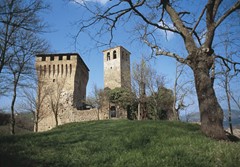Municipality of Casina.
Castle of Sarzano
Amongst the castles from Matilda’s times scattered across the hillsides near Reggio one that stands out is the ancient Castle of Sarzano, now completely restored after twenty years’ work. The first mention we have of Sarzano is in a deed of sale from 958 on the part of Atto Adalberto, Matilda of Canossa’s ancestor. Amongst the vast network of fortifications built to defend Matilda’s territory, this castle occupied a prominent position, on a strategic thoroughfare that climbed away from Reggio towards the mountain passes leading to Tuscany.
Moreover, given its central position in the network of hillside defences, it was in visual contact with the other castles of Carpineti, Baiso, Rossena and Canossa. In a document from 1116, the year after Matilda’s death, ownership of the castle and the chapel was granted by Emperor Henry V to the monks of Sant'Apollonio of Canossa. In 1287, the Fogliani family took possession and held on to the castle through thick and thin until 1507, when the Bertrando part was ceded to the Canossa family and over the next centuries to a series of feudal families.
The fine castle complex has retained the key elements of the fortified structure from Matilda’s times - albeit difficult to discern - which normally included one tower separated from the feudal residence which, in the case of Sarzano, was a proper nobleman’s palace topped with battlements including trapdoors and with a grand raised portal for defence. Originally the castle sat within three rings of walls. The lowest one, which nowadays corresponds to the ring road, had three gateways and included the church and a civil dwelling. The middle ring included a small square to protect the inhabitants delimited by a moat and drawbridge, while the uppermost one surrounded a courtyard, the tower and the keep.
The current layout dates back to the XV century, in the reign of Nicolò III d'Este, while the appearance that the recent restorations have given us belongs to the final historical refurbishment, made at the end of the seventeenth century by the last feudatories of Sarzano, the Marquis Paolo Carandini and his wife, Francesca Graziani. It features a double line of walls, a fine fortified entrance portal topped by the Carandini family crest, a courtyard, the keep, the square tower and, lastly, the recently unearthed archaeological remains of various religious buildings. The Torrazzo – or keep – is the most interesting element of the castle complex, while at its side rises the elegant, 20-metre tall Cassero tower. Until 1960 this was used as a belltower, however its original characteristics remain almost intact, with its facing in regularly laid squared-off blocks of stone, a typical medieval construction technique. During the restoration of the castle walls, the remains of older fortifications came to light.
Along the eastern edge of the upper courtyard the outer walls traced the plan of two buildings, one of these with a characteristic semi-circular shape, where tombs and ossuaries were found, dug out of the bare rock. These are probably the remains of the church or oratory of a military camp built on top of the hill. The bedrock has been found 1 metre 30 below the current ground level. On top of the dark earth are many fragments of coal and ceramic material dating back to a time between the X and the XIV century. Let’s go down to the church of San Bartolomeo below, at the level of today’s ring road. This features a single nave with a rectangular apse and two side chapels.
Of interest are the five crypts and the Early Christian altar of square stones below the floor level of the current church, an unexpected discovery made during the restoration work. Notable also are the traces of a decorative fresco from the sixteenth-seventeenth centuries on the walls of the apse and the painted wooden choir dating back to the early 1900s. Both the church and the tower are now used for cultural events, while the rectory, the sharecropper’s house and the adjacent hayloft currently house the inn and the restaurant, available for those who wish to enjoy staying for a while to discover the sites and history of Matilda of Canossa. Also around Sarzano there are artistic and architectural remains just waiting to be discovered and visited, such as ancient villages, tower houses and various places of worship. Of note are the rural nucleus of Vercallo which has a XVI century appearance, but is documented as already existing in the XI century; the church of Pianzo, dedicated to Santa Maria Assunta, is of Lombard origin, while the later Romanesque layout underwent heavy alterations in the 1700s.
The beautiful parish church of San Bartolomeo di Paullo dates back to the X century, and despite various modifications has kept its original appearance and proportions with a basilica plan that features three naves, and columns topped by striking Romanesque capitals. Some musts are the XIV century Castle of Lèguigno, the Romanesque oratory of Beléo, and the medieval villages of Bèrgogno, Monchio dei Ferri and Montale.
